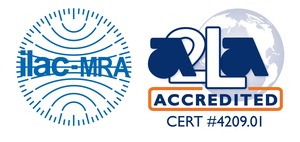Determination of Gold in Bullion
Schedule: May, November
Reduced Price

Accredited Proficiency Testing Provider*
This program is accredited in accordance with the recognized International Standard ISO/IEC 17043: 2010 Conformity Assessment - General Requirements for Proficiency Testing, by the American Association for Laboratory Accreditation. Certificate Number: 4209.01
About The Program
Fire assay cupellation has been used by gold refiners, fabricators, mines, and mints for the analysis of gold in bullion. This program provides participating laboratories the opportunity to evaluate the accuracy of their assays, using a clear and defined standardized testing procedure. Over 30 laboratories participate in the program. ASTM's Committee E01 on Analytical Chemistry of Metals, Ores, and Related Materials, consisting of over 190 members and developer of over 140 standards, provides the technical direction for these programs.
The data generated will be statistically analyzed. Final summary reports, provided to participants only, contain:
- Each participating laboratory's test results (coded for confidentiality)
- Statistical analysis of test data
- Charts plotting test results versus laboratory code
We will accept registration for this program until April 1st to participate in the May and November test Cycles. Orders received after April 1st will only be able to participate in the November test cycle at full price.
Exception: Proration of your fee for the program is made for those companies participating in the program for the first time.
For more information, contact us.
Test Samples
Test samples are provided by the Metalor USA Refining Corp. The samples provided are homogeneity tested in accordance with Part A of ASTM E 1335 Test Methods for Determination of Gold in Bullion by Cupellation. At the conclusion of testing, laboratories keep the remaining test sample material. Samples are wire (<2mm) or pin tube and are representative of the following concentration ranges of gold: high-range, 90-99 percent Au, 5-9 percent Ag, 0-3 percent Cu; mid-range, 60-90 percent Au, 10-40 percent Ag, 1-5 percent Cu; low-range, 25-60 percent Au, balance Ag, 1-5 percent Cu. Each lab receives two samples each test cycle with one sample each from two of the three ranges above.
Test Methods
- ASTM E1335 — Standard Test Methods for Determination of Gold in Bullion by Fire Assay Cupellation Analysis
Distribution Of Samples
Samples distributed from Metalor USA. Shipping cost is included in the registration fee.
- You are responsible for additional fees charged-back to our distributor for any reason relative to your sample shipment including, but not limited to, fees for fuel surcharges, missing/invalid account numbers, dangerous goods, remote area delivery, and multiple delivery attempts.
Program Requirements
Participation is on an annual fee basis and open to all laboratories. Registration fees must be paid in advance to participate. Testing must be performend within the participant's laboratory facilities. A laboratory does not need to perform all the program tests to participate.
About Astm International Committee E01
Committee E01 on Analytical Chemistry of Metals, Ores, and Related Materials, consisting of over 190 members and developer of over 140 standards, provides the technical derection for the program. Test information generated in the program is utilized by Committee E01 to determine if the modifications to ASTM documents or new standards are warrented.
Why Should Your Laboratory Participate?
These programs are designed to provide participating laboratories with a statistical quality assurance tool enabling them to assess their performance in how they conduct a given test or series of tests by comparing their data against the data of other participating laboratories.
You receive test results available only to participating laboratories that will help you:
- Monitor strengths and weaknesses of your laboratory's performance
- Periodically compare your test results and calculated statistical parameters with other laboratories
Should you have an issue with your published results, please write to ptp@astm.org with your lab number and account number.
